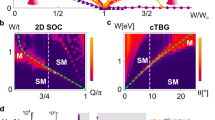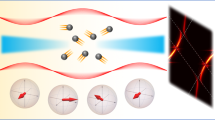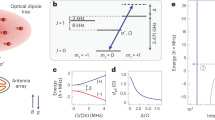Abstract
Dispersion forces are long-range interactions between polarizable objects that arise from fluctuations in the electromagnetic field between them. Dispersion forces have been observed between microscopic objects such as atoms and molecules (the van der Waals interaction)1, between macroscopic objects (the Casimir interaction)2 and between an atom and a macroscopic object (the Casimir–Polder interaction)2,3. Dispersion forces are known to increase the attractive forces between the components in nanomechanical devices4, to influence adsorption rates onto nanostructures5, and to influence the interactions between biomolecules in biological systems1. In recent years, there has been growing interest in studying dispersion forces in nanoscale systems6,7,8 and in exploring the interactions between carbon nanotubes and cold atoms9,10,11. However, there are considerable difficulties in developing dispersion force theories for general, finite geometries such as nanostructures. Thus, there is a need for new experimental methods that are able to go beyond measurements of planar surfaces12,13,14,15 and nanoscale gratings16 and make measurements on isolated nanostructures. Here, we measure the dispersion force between a rubidium atom and a multiwalled carbon nanotube by inserting the nanotube into a cloud of ultracold rubidium atoms and monitoring the loss of atoms from the cloud as a function of time. We perform these experiments with both thermal clouds of ultracold atoms and with Bose–Einstein condensates. The results obtained with this approach will aid the development of theories describing quantum fields near nanostructures, and hybrid cold-atom/solid-state devices may also prove useful for applications in quantum sensing and quantum information17,18.
This is a preview of subscription content, access via your institution
Access options
Subscribe to this journal
Receive 12 print issues and online access
$259.00 per year
only $21.58 per issue
Buy this article
- Purchase on Springer Link
- Instant access to full article PDF
Prices may be subject to local taxes which are calculated during checkout




Similar content being viewed by others
References
Parsegian, V. A. Van der Waals forces: A Handbook for Biologists, Chemists, Engineers, and Physicists (Cambridge Univ. Press, 2006).
Bordag, M., Klimchitskaya, G. L. & Mohideen, U. Advances in the Casimir Effect (Oxford Univ. Press, 2009).
Scheel, S. & Buhmann, S. Y. Macroscopic quantum electrodynamics—concepts and applications. Acta Phys. Slovaca 58, 675–809 (2008).
Bormuth, V., Varga, V., Howard, J. & Schäffer, E. Protein friction limits diffusive and directed movements of kinesin motors on microtubules. Science 325, 870–873 (2009).
Rance, G. A., Marsh, D. H., Bourne, S. J., Reade, T. J. & Khlobystov, A. N. Van der Waals interactions between nanotubes and nanoparticles for controlled assembly of composite nanostructures. ACS Nano 4, 4920–4928 (2010).
Milton, K. The Casimir force: feeling the heat. Nature Phys. 7, 190–191 (2011).
Klimchitskaya, G. L., Mohideen, U. & Mostepanenko, V. M. The Casimir force between real materials: experiment and theory. Rev. Mod. Phys. 81, 1827–1885 (2009).
Bruch, L. W. Evaluation of the van der Waals force for atomic force microscopy. Phys. Rev. B 72, 033410 (2005).
Petrov, P. G. et al. Trapping cold atoms using surface-grown carbon nanotubes. Phys. Rev. A 79, 043403 (2009).
Goodsell, A., Ristroph, T., Golovchenko, J. A. & Hau, L. V. Field ionization of cold atoms near the wall of a single carbon nanotube. Phys. Rev. Lett. 104, 133002 (2010).
Kálmán, O., Kiss, T., Fortágh, J. & Domokos, P. Quantum galvanometer by interfacing a vibrating nanowire and cold atoms. Nano Lett. 12, 435–439 (2012).
Lin, Y., Teper, I., Chin, C. & Vuletić, V. Impact of the Casimir–Polder potential and Johnson noise on Bose–Einstein condensate stability near surfaces. Phys. Rev. Lett. 92, 050404 (2004).
Obrecht, J. M. et al. Measurement of the temperature dependence of the Casimir–Polder force. Phys. Rev. Lett. 98, 063201 (2007).
Hunger, D. et al. Resonant coupling of a Bose–Einstein condensate to a micromechanical oscillator. Phys. Rev. Lett. 104, 143002 (2010).
Bender, H., Courteille, P. W., Marzok, C., Zimmermann, C. & Slama, S. Direct measurement of intermediate-range Casimir–Polder potentials. Phys. Rev. Lett. 104, 083201 (2010).
Cronin, A. D., Schmiedmayer, J. & Pritchard, D. E. Optics and interferometry with atoms and molecules. Rev. Mod. Phys. 81, 1051–1129 (2009).
Birkl, G. & Fortágh J. Micro traps for quantum information processing and precision force sensing. Laser Photon. Rev. 1, 12–23 (2007).
Wallquist, M., Hammerer, K., Rabl, P., Lukin, M. & Zoller, P. Hybrid quantum devices and quantum engineering. Phys. Scripta T137, 014001 (2009).
Löffler, R. et al. Optimization of plasma-enhanced chemical vapor deposition parameters for the growth of individual vertical carbon nanotubes as field emitters. Carbon 49, 4197–4203 (2011).
Gierling, M. et al. Cold-atom scanning probe microscopy. Nature Nanotech. 6, 446–451 (2011).
Ketterle, W., Durfee, D. S. & Stamper-Kurn, D. M. in Proceedings of the International School of Physics—Enrico Fermi (eds Inguscio, M., Stringari, S. & Wieman, C. E.) 67–176 (IOS Press, 1999).
Barash, Y. S. & Kyasov, A. A. Interaction potential for two filaments and for an atom interacting with a filament. Sov. Phys. JETP 68, 39–45 (1989).
Boustimi, M., Baudon, J., Candori, P. & Robert, J. van der Waals interaction between an atom and a metallic nanowire. Phys. Rev. B 65, 155402 (2002).
Blagov, E. V., Klimchitskaya, G. L. & Mostepanenko, V. M. Van der Waals interaction between microparticle and uniaxial crystal with application to hydrogen atoms and multiwall carbon nanotubes. Phys. Rev. B 71, 235401 (2005).
Fermani, R., Scheel, S. & Knight, P. L. Trapping cold atoms near carbon nanotubes: thermal spin flips and Casimir–Polder potential. Phys. Rev. A 75, 062905 (2007).
Eberlein, C. & Zietal, R. Retarded Casimir–Polder force on an atom near reflecting microstructures. Phys. Rev. A 80, 012504 (2009).
Landau, L. D. & Lifshitz, E. M. Mechanics 3rd edn (Butterworth-Heinemann, 2001).
Fink, M. et al. s-wave scattering of a polarizable atom by an absorbing nanowire. Phys. Rev. A 81, 062714 (2010).
Judd, T. E. et al. Zone-plate focusing of Bose–Einstein condensates for atom optics and erasable high-speed lithography of quantum electronic components. New J. Phys. 12, 063033 (2010).
Judd, T. E., Scott, R. G. & Fromhold, T. M. Atom–chip diffraction of Bose–Einstein condensates: the role of interatomic interactions. Phys. Rev. A 78, 053623 (2008).
Hammerer, K., Aspelmeyer, M., Polzik, E. S. & Zoller, P. Establishing Einstein–Poldosky–Rosen channels between nanomechanics and atomic ensembles. Phys. Rev. Lett. 102, 020501 (2009).
Acknowledgements
The authors thank B. Jetter and J. Märkle for supporting the Hamaker calculations and R. Walser, M. Schneider, H. Friedrich, M. Fink, J. Eiglsperger and J. Madroñero for helpful discussions. The authors acknowledge financial support from the BMBF (NanoFutur 03X5506) and the DFG (SFB TRR21, projects C9 and C10). A.G. and T.E.J. acknowledge financial support from the Baden-Württemberg RiSC programme, P.S. from the Studienstiftung des Deutschen Volkes, and M.G. from the Evangelisches Studienwerk Villigst. The authors also acknowledge the use of BW-grid computing resources and support from the BW Stiftung ‘Kompetenznetz Funktionelle Nanostrukturen’.
Author information
Authors and Affiliations
Contributions
A.G. and J.F. contributed to the experimental idea and supervised the project. P.S., M.G., A.G. and J.F. designed and set up the experiment. G.V. and D.K. fabricated the nanochip. P.S. and M.G. performed the experiments. P.S., M.G., T.E.J., A.G. and J.F. analysed the data and discussed the results.
Corresponding authors
Ethics declarations
Competing interests
The authors declare no competing financial interests.
Rights and permissions
About this article
Cite this article
Schneeweiss, P., Gierling, M., Visanescu, G. et al. Dispersion forces between ultracold atoms and a carbon nanotube. Nature Nanotech 7, 515–519 (2012). https://doi.org/10.1038/nnano.2012.93
Received:
Accepted:
Published:
Issue Date:
DOI: https://doi.org/10.1038/nnano.2012.93
This article is cited by
-
Dynamical Casimir–Polder force on a two-level atom with superposition state in a cavity comprising a dielectric
Scientific Reports (2020)
-
Cascaded collimator for atomic beams traveling in planar silicon devices
Nature Communications (2019)
-
Cold atoms feel the force
Nature Nanotechnology (2012)



